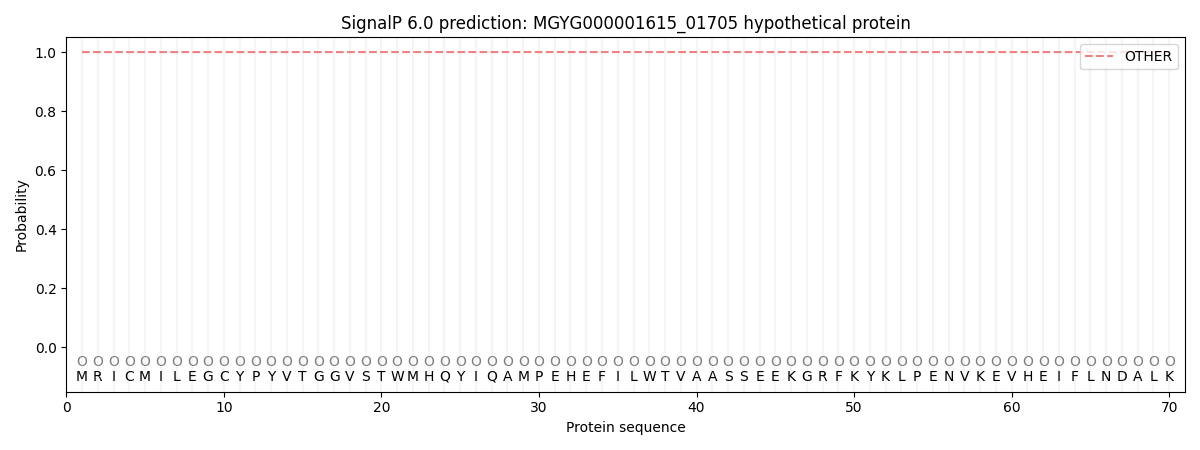You are browsing environment: HUMAN GUT
CAZyme Information: MGYG000001615_01705
You are here: Home > Sequence: MGYG000001615_01705
Basic Information |
Genomic context |
Full Sequence |
Enzyme annotations |
CAZy signature domains |
CDD domains |
CAZyme hits |
PDB hits |
Swiss-Prot hits |
SignalP and Lipop annotations |
TMHMM annotations
Basic Information help
| Species | Eisenbergiella sp900548905 | |||||||||||
|---|---|---|---|---|---|---|---|---|---|---|---|---|
| Lineage | Bacteria; Firmicutes_A; Clostridia; Lachnospirales; Lachnospiraceae; Eisenbergiella; Eisenbergiella sp900548905 | |||||||||||
| CAZyme ID | MGYG000001615_01705 | |||||||||||
| CAZy Family | GT4 | |||||||||||
| CAZyme Description | hypothetical protein | |||||||||||
| CAZyme Property |
|
|||||||||||
| Genome Property |
|
|||||||||||
| Gene Location | Start: 91386; End: 92798 Strand: + | |||||||||||
CDD Domains download full data without filtering help
| Cdd ID | Domain | E-Value | qStart | qEnd | sStart | sEnd | Domain Description |
|---|---|---|---|---|---|---|---|
| cd03813 | GT4-like | 5.77e-161 | 2 | 461 | 1 | 473 | glycosyltransferase family 4 proteins. This family is most closely related to the GT4 family of glycosyltransferases. Glycosyltransferases catalyze the transfer of sugar moieties from activated donor molecules to specific acceptor molecules, forming glycosidic bonds. The acceptor molecule can be a lipid, a protein, a heterocyclic compound, or another carbohydrate residue. This group of glycosyltransferases is most closely related to the previously defined glycosyltransferase family 1 (GT1). The members of this family may transfer UDP, ADP, GDP, or CMP linked sugars. The diverse enzymatic activities among members of this family reflect a wide range of biological functions. The protein structure available for this family has the GTB topology, one of the two protein topologies observed for nucleotide-sugar-dependent glycosyltransferases. GTB proteins have distinct N- and C- terminal domains each containing a typical Rossmann fold. The two domains have high structural homology despite minimal sequence homology. The large cleft that separates the two domains includes the catalytic center and permits a high degree of flexibility. The members of this family are found mainly in bacteria, while some of them are also found in Archaea and eukaryotes. |
| NF038011 | PelF | 1.81e-110 | 3 | 461 | 2 | 489 | GT4 family glycosyltransferase PelF. Proteins of this family are components of the exopolysaccharide Pel transporter. It has been reported that PelF is a soluble glycosyltransferase that uses UDP-glucose as the substrate for the synthesis of exopolysaccharide Pel, whereas PelG is a Wzx-like and PST family exopolysaccharide transporter. |
| pfam11997 | DUF3492 | 1.56e-91 | 1 | 257 | 1 | 278 | Domain of unknown function (DUF3492). This presumed domain is functionally uncharacterized. This domain is found in bacteria, archaea and eukaryotes. This domain is typically between 259 to 282 amino acids in length. This domain is found associated with pfam00534. This domain has two conserved sequence motifs: GGVS and EHGIY. |
| cd03801 | GT4_PimA-like | 7.33e-31 | 104 | 462 | 25 | 366 | phosphatidyl-myo-inositol mannosyltransferase. This family is most closely related to the GT4 family of glycosyltransferases and named after PimA in Propionibacterium freudenreichii, which is involved in the biosynthesis of phosphatidyl-myo-inositol mannosides (PIM) which are early precursors in the biosynthesis of lipomannans (LM) and lipoarabinomannans (LAM), and catalyzes the addition of a mannosyl residue from GDP-D-mannose (GDP-Man) to the position 2 of the carrier lipid phosphatidyl-myo-inositol (PI) to generate a phosphatidyl-myo-inositol bearing an alpha-1,2-linked mannose residue (PIM1). Glycosyltransferases catalyze the transfer of sugar moieties from activated donor molecules to specific acceptor molecules, forming glycosidic bonds. The acceptor molecule can be a lipid, a protein, a heterocyclic compound, or another carbohydrate residue. This group of glycosyltransferases is most closely related to the previously defined glycosyltransferase family 1 (GT1). The members of this family may transfer UDP, ADP, GDP, or CMP linked sugars. The diverse enzymatic activities among members of this family reflect a wide range of biological functions. The protein structure available for this family has the GTB topology, one of the two protein topologies observed for nucleotide-sugar-dependent glycosyltransferases. GTB proteins have distinct N- and C- terminal domains each containing a typical Rossmann fold. The two domains have high structural homology despite minimal sequence homology. The large cleft that separates the two domains includes the catalytic center and permits a high degree of flexibility. The members of this family are found mainly in certain bacteria and archaea. |
| cd03808 | GT4_CapM-like | 4.24e-30 | 79 | 458 | 14 | 358 | capsular polysaccharide biosynthesis glycosyltransferase CapM and similar proteins. This family is most closely related to the GT4 family of glycosyltransferases. CapM in Staphylococcus aureus is required for the synthesis of type 1 capsular polysaccharides. |
CAZyme Hits help
| Hit ID | E-Value | Query Start | Query End | Hit Start | Hit End |
|---|---|---|---|---|---|
| AHJ16615.1 | 1.94e-228 | 1 | 461 | 1 | 461 |
| AUD94380.1 | 1.94e-228 | 1 | 461 | 1 | 461 |
| AEF26773.1 | 1.11e-227 | 1 | 461 | 1 | 461 |
| QFV13383.1 | 1.11e-227 | 1 | 461 | 1 | 461 |
| ALE14227.1 | 1.11e-227 | 1 | 461 | 1 | 461 |
Swiss-Prot Hits help
SignalP and Lipop Annotations help
This protein is predicted as OTHER

| Other | SP_Sec_SPI | LIPO_Sec_SPII | TAT_Tat_SPI | TATLIP_Sec_SPII | PILIN_Sec_SPIII |
|---|---|---|---|---|---|
| 1.000039 | 0.000000 | 0.000000 | 0.000000 | 0.000000 | 0.000000 |
